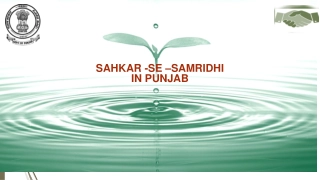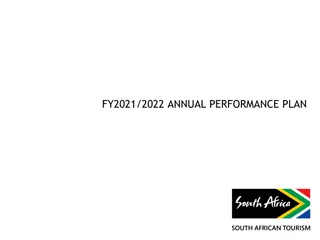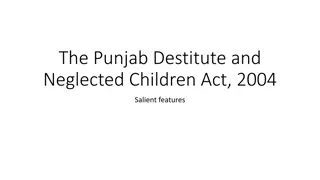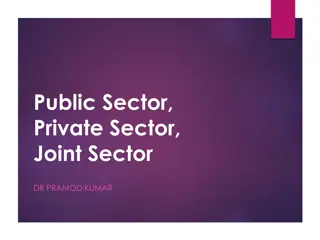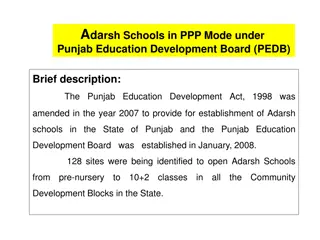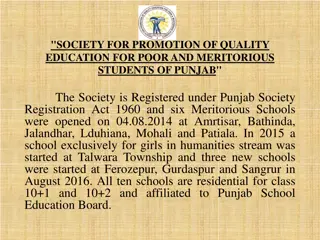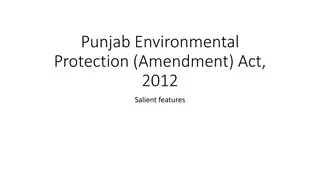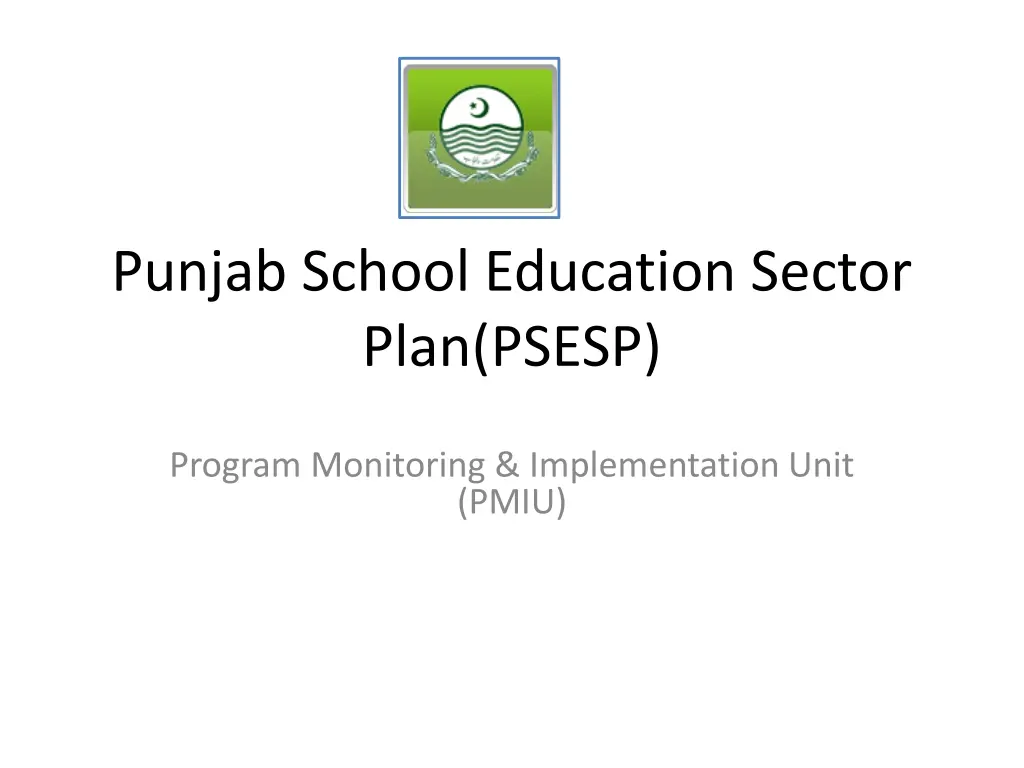
Punjab School Education Sector Plan (PSESP) Overview and Challenges
Explore the Punjab School Education Sector Plan (PSESP) focusing on strategic objectives, monitoring indicators, and the challenges faced in implementing Article 25-A. Discover the structure of the education sector, public-private partnerships, and findings from a situation analysis in this comprehensive overview. Learn about the key factors influencing the quality and efficiency of education delivery in Punjab.
Download Presentation

Please find below an Image/Link to download the presentation.
The content on the website is provided AS IS for your information and personal use only. It may not be sold, licensed, or shared on other websites without obtaining consent from the author. If you encounter any issues during the download, it is possible that the publisher has removed the file from their server.
You are allowed to download the files provided on this website for personal or commercial use, subject to the condition that they are used lawfully. All files are the property of their respective owners.
The content on the website is provided AS IS for your information and personal use only. It may not be sold, licensed, or shared on other websites without obtaining consent from the author.
E N D
Presentation Transcript
Punjab School Education Sector Plan(PSESP) Program Monitoring & Implementation Unit (PMIU)
Structure of the Sector Plan Time Frame 5 years Strategic Objectives Strategies & Estimated Cost Monitoring Indicators Oversight Mechanism Review Process
Strategic Framework for PSESP PSESP development has been guided by the: National Education Policy 2009 Millennium Development Goals Punjab Education Sector Reforms Programme Article 25-A (18thConstitutional Amendment) Chief Minister s School Reforms Road Map (Govt. of Punjab year 2011) and focusing on: Differing roles of various service delivery modes-public: private etc. Balancing quality, relevance, access, equity and governance
Challenge of Article 25A Indicator Current Target NER Primary 70 100 NER Middle 37 100 Access (NFE) NER Secondary 25 100 Survival Rate Primary 57 100 Equity Quality Survival Rate Middle 86 100 Survival Rate Secondary 59 100 Transition Rate Katchi to Primary 62 100 ECE Transition Rate Primary to Middle 91 100 Transition Rate Middle to Secondary 106 100 Source: EMIS 2011and PSLM 2011
Structure of the Education Sector Public Private Partnership Public Sector Private Sector Madrassas Non Formal Education
Findings of Situation Analysis Input- focused interventions Strengths Challenges High Political Will Cross-cutting Issues: Reform Environment Information and research deficit Educational Indicators better than other provinces Governance Issues Fulfilling the requirements of the 18th Amendment Pioneering province to shift policy focus towards Quality First province to start rationalization of staff and schools Shortage of specialists and experts Absence of Quality Standards Punjab School Education Sector Weak coordination between implementers
Challenges of Sub-Sectors Public Private Partnership Public Sector Private Sector Excess Capacity in schools Relatively better quality Lower unit costs Relatively better quality Key Factor to Consider Weak Quality Low Efficiency High Unit Costs Unregulated Unclear outcomes Limited capacity to scale up Key Weaknesses Regulation of the Sector Quality Governance & Mgmt Build Scale up Capacity Primary Strategic Approach
Structural Framework of PSESP Enrolment Teaching Learning Assessment Management Participation Curriculum Textbooks Teacher qualifications Infrastructure Environment Test scores SLOs Completion rate Pass rate Output/Re sult Inputs Process
Cross-cutting Themes Minimum Standards (Inputs, Processes, Outputs) Capacity Development Coordination Awareness
Strategic Objectives Quality 1. Standards for all education inputs, process, outputs 2. Capacity development for Curriculum Implementation Framework 3. Aligning Pre-service and In-service Teacher Education based on the Punjab Teacher Education Strategy 4. Capacity development to prepare and disseminate high quality textbooks 5. Enhance expertise in assessment and evaluation 6. Development of physical and social environment in schools
Access with Equity & Relevance 1. Establish Early Childhood Programs 2. Preparing a school language policy 3. Provision of stipends/incentives (minimizing costs of education for the poorest) 4. Mobilizing School Councils and community participation 5. Develop formal linkages between NFE and regular schools 6. Develop linkages between general education and TVE 7. Develop and implement policy on Disaster Risk Reduction 8. Focus on Inclusive education through Child-friendly schools
Governance & Management of Public Education Sector 1. Merit based HRM-Recruitment, Performance Appraisal and Promotions, Retention of Quality Managers Development of capacity to improve managerial efficiency at the provincial and district level Data-based decision-making and increasing scope of EMIS Developing oversight mechanism for sector plan implementation and improve monitoring and evaluation processes Gender-sensitized management Utilize PEF s capacity to achieve targets of Article 25-A School-based budgeting Integrate private sector into government s policy framework Effective community involvement 2. 3. 4. 5. 6. 7. 8. 9.
Implementation Strategies Oversight Mechanism Decentralisation Dissemination PMIU as Secretariat Implementation Framework Performance Assessment Framework Implementation level indicators Monitoring Stakeholders Involvement Strategies based on analysis
Way Forward PSESP Dissemination (district level) Steering Structure (committee) for effective implementation PSESP (SED Level) to be notified Notification of Thematic Working Groups (Quality, Access & Governance) Development and Alignment of Annual Development Plans of attached departments with PSESP Capacity Development Strategy Resource Mobilization Plan & Donors/Partners Coordination Performance Assessment Framework (mechanism)
Costing Estimates of Out of School population based on: Population Projections of National Institute of Population Studies (NIPS) NER trend from PSLMs Ratios: Classroom 1:50; Teachers 1:50, 3:50 and 4:50 for primary, middle and secondary Use of official Unit costs Estimates for public sector and PPP approach Costing of the 5 year plan is an estimate Financing component will be reviewed on an ongoing basis It is a cyclical process- a few additional costs will emerge from implementation itself
Costing Strategies Utilise excess capacity available in public sector Balanced division between PPP and Public sector Infrastructure expansion only for quality related issues: Separate approach for costing of quality and governance strategies Increase number of 5 room primary schools Introduction and expansion of pre-primary ECE
Non Scale Costs Quality Relevance Access Governance Improved Managerial Efficiency Monitoring and Evaluation
Estimated Additional Costing for Sector Plan (2013-18) Components Recurrent Cost (in Rs. Million) Year 2013-14 2014-15 2015-16 2016-17 2017-18 Est. Routine Budget 205.15 bn 245.07 bn 308.06 bn 393.01 bn 496.22 bn Teacher Salary 18020.34 24187.75 30262.18 37894.42 46683.80 PEC (additional assessment cost) 624.71 695.79 920.02 942.55 975.69 Textbooks (additional enrollment) 102.92 210.31 193.24 124.65 130.21 Teachers Training (new teachers) 407.3 949.07 986.94 641.15 618.19
Estimated Additional Costing for Sector Plan (2013-18) Components Development Cost (in Rs. Million) Year 2013-14 2014-15 2015-16 2016-17 2017-18 New Schools/ Up gradation 0.00 8,500.00 14,535.00 14,535.00 9,690.00 Additional Classroom 1,767.82 1,824.92 1,824.92 1,824.92 1,824.92 Quality (Develop Standards, Assessment Tools/Reforms, Teacher Learning Development) 1,179.47 1,105.62 0.00 0.00 0.00 Relevance (Tracer Study, Review of Curriculum Syllabus, Linkages b/w HE and SE & TVET) 32.88 5,63 0.00 0.00 0.00
Estimated Additional Costing for Sector Plan (2013-18) Components Development Cost (in Rs. Million) Year 2013-14 2014-15 2015-16 2016-17 2017-18 Governance (HRM, Performance Appraisal System, Recruitment Process, Capacity Development Plan - CD) 63.25 1.50 0.00 0.00 0.00 Improved Management (Recruitment Policy, CD plan developed, Training Needs Assessment tools) 23.50 0.00 0.00 0.00 0.00 Monitoring & Evaluation (Performance Assessment Framework, Existing Capacity Assessment) 48.00 0.00 0.00 0.00 0.00 Total Budget in Billions 22.30 37.481 48.722 55.963 59.923

